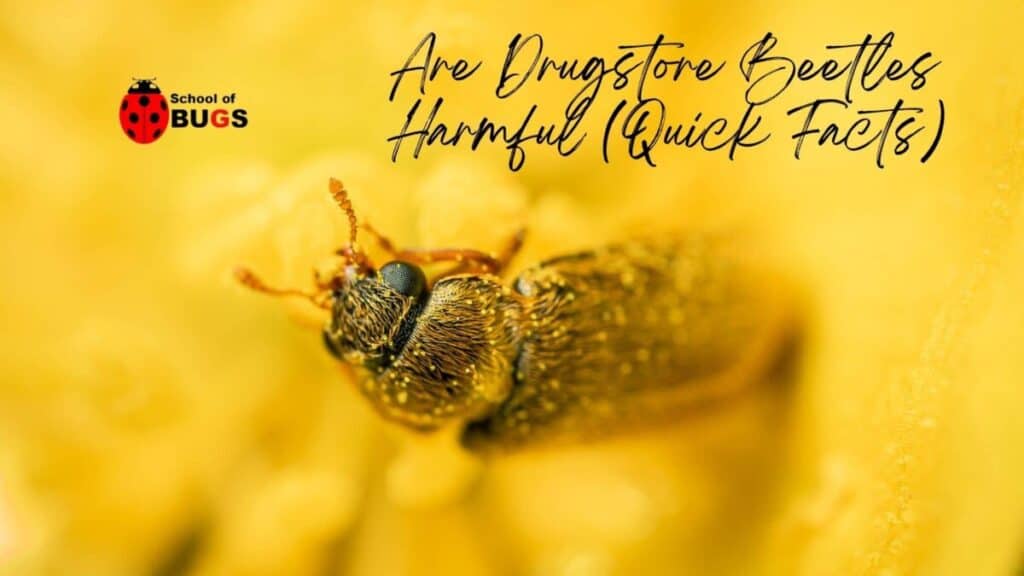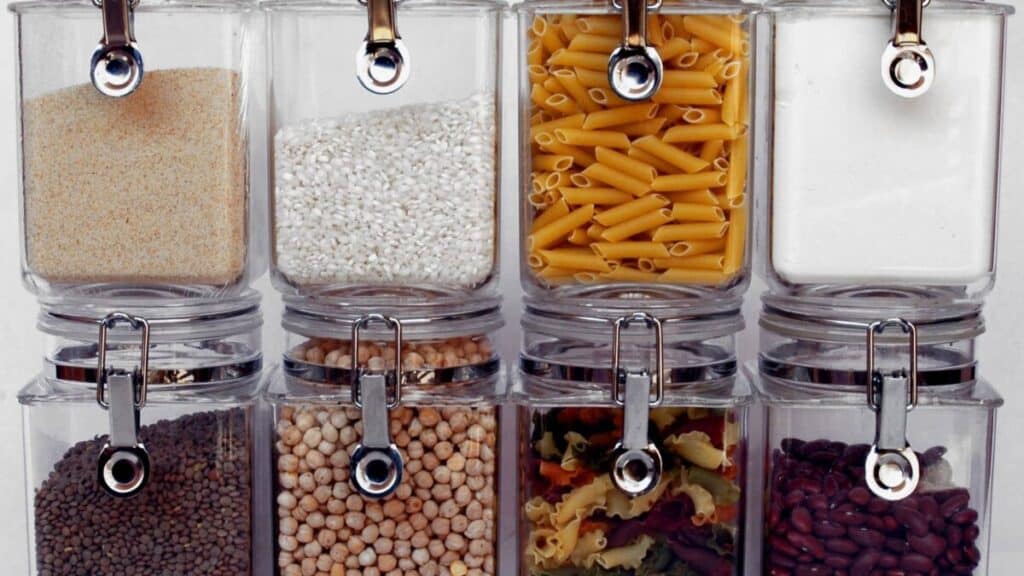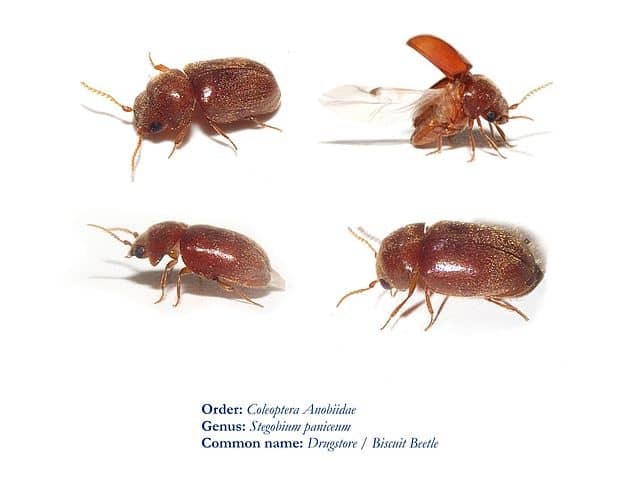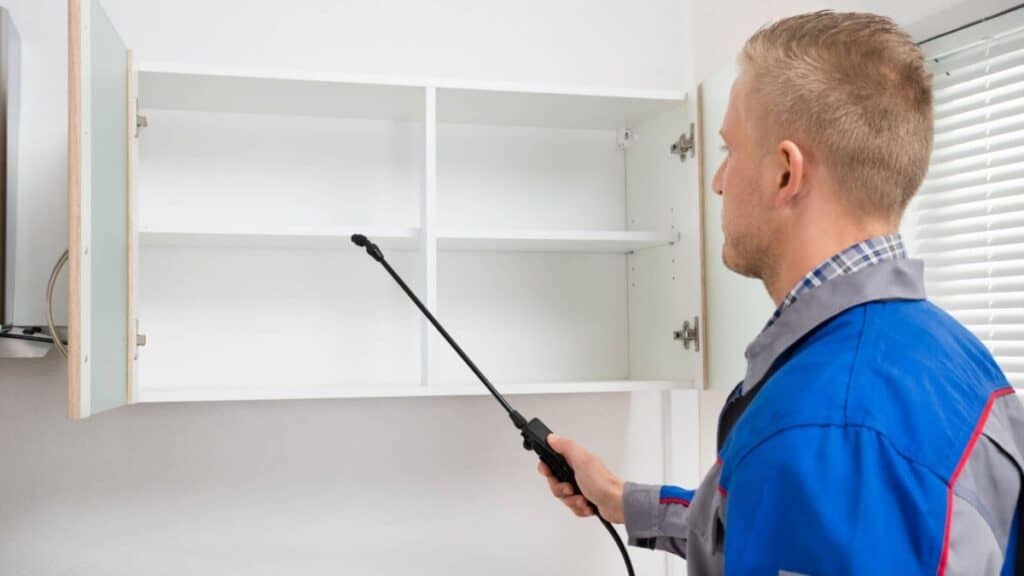
Biscuit beetles, otherwise known as “Drugstore Beetles” or “Cigarette Beetles” are considered to be a “commercial” pest, as they frequent bulk dried good supplies in marketplaces and grocery stores all over the country.
Drugstore beetles are harmful because of their destructive capacity to grain stores and other dried goods, whether it is a commercial business or residential.
The females lay hundreds of eggs, infecting and destroying all the bulk goods they come into contact with.
Their destructive potential is both financial and burdensome as they can cause hundreds of thousands of dollars in damage, depriving grocery stores and communities of the goods that they need to both sell and consume.
Seeing as Drugstore Beetles can be quite the pests indeed, there are several facts that you should know about them. As the saying goes, “know thine enemy.”
- What does the Drugstore Beetle look like?
- What does the Drugstore Beetle prefer to inhabit?
- Drugstore Beetle reproduction and life cycle
- What does the Drugstore Beetle feed on?
- How to detect a Drugstore Beetle infestation
- How to get rid of a Drugstore Beetle infestation
- How to prevent a Drugstore Beetle infestation
What Does the Drugstore Beetle Look Like?

The biggest problem with the Drugstore beetle is that it is so damnable tiny and difficult to see. It is easy to mistake for a mite, an ant, or even a tick.
It’s very difficult to tell whether or not you have an infestation until it is already well underway.
A fully grown, mature Drugstore Beetle is no more than 1/10 of an inch and typically reddish-brown, although it can lean more towards one solid color or the other.
Under a magnifying glass, you will observe the lines that run in the direction of the length of the wing.
Up close, the Drugstore Beetle always appears to be looking down.
Their young (larvae) are nothing more or less than what you would think of as a grub, curled in on themselves, pale white or off-white, and very, very small.
What Does the Drugstore Beetle Prefer to Inhabit?
Primarily, Drugstore Beetles will spend their time in pantries, cabinet spaces, underneath sinks, and anywhere that food is abundant, is warm, and there is a source of water.

Since these beetles can fly, they can cover ground quickly, getting to where they need to be.
The fact that they can fly makes them all the more pertinacious and intimidating to those who are afraid of flying insects.
They can get in your house through open doors, windows, cracks, crevices, unsealed areas, poorly maintained plumbing infrastructure, and they can hitch rides on items carried inside.
Once there, they will find a source of safety and security where they can breed and the females can lay eggs without disturbance.
Drugstore Beetle Reproduction and Life Cycle
The female Drugstore Beetle is a baby-making monster, easily spitting out over 100 eggs at a time.
Of course, this level of egg-laying makes sense, because Drugstore Beetles have a maximum lifespan of around 65 days.
The eggs are tiny and white. Depending on where they are lain—most likely in your bag of white rice, croutons, or your box of favorite pasta—you will probably never see them.
Once the little Drugstore Beetles hatch (a cycle of egg to hatch which lasts no longer than 10 days) they will reach maturity in 18 to 25 days.

That means new females are flitting about, blasting your dried goods with a century of white, sticky eggs, once a month.
If you ever discover a Drugstore Beetle infestation, you may want to reconsider shrimp fried rice for lunch. It also goes to show you just how rapidly an infestation can get completely out of control.
What Does the Drugstore Beetle Feed On?
Drugstore Beetles love dried goods, which means that their primary target is going to be your pantry.
Since this is the spot where they will feed the most, it’s also the spot where they will lay their eggs, as in, directly in your dried goods.
They will feed on rice mostly, but they have no real aversion towards eating other dried goods such as beans, pasta, bread, cereal, oatmeal, peanuts, flour, and grits.

They aren’t very picky, so long as they can work their way through cardboard and plastic which, of course, they can.
Outside of your pantry, Drugstore Beetles are very indiscriminate. They received their interesting moniker because once upon a time when drugstores were less secure than they are today, Drugstore Beetles would infest pharmacies, feeding on all of the herbs that went into the medicines.
They can’t do that much anymore, but that certainly hasn’t stopped them from moving on to bigger and better things, such as leather, books, loose-leaf paper, dry pet foods, hair, cloth (especially wool), and spices.
They can dig through just about anything, even thin sheets of metal, like those extra-thick panels of aluminum foil. In other words, unless you encase your food stores in steel, you can’t keep them out.
How Do You Know You’re Being Infested?
After the above feeding habits have been tallied off in your head, you can only imagine how detecting these things will look.
Aside from several of them buzzing by your ear when you open the pantry, it’s not too hard to realize that something is seriously wrong.

Since Drugstore Beetles can burrow through just about anything that contains dried goods inside, you’ll notice holes in your bags, holes in your cardboard, holes in anything covered in aluminum foil, and more.
They will likely leave crumbs behind, which will be a mixture of the trash leftover from their digging and the crumbs from the food that has fallen out.
You’ll likely spot tiny piles of your dried goods laying around, like rice, beans, and small pasta.
Since they love to burrow and dig into the wood, you may find small granules of sawdust in little piles as well as expanded crevices and cracks that existed before but are now suspiciously larger.
How to Eliminate a Drugstore Beetle Infestation?
Start by removing everything from your cabinets, pantries, and anywhere else that you have dried goods stored.
Eliminating the attraction is a head start towards eliminating the problem. You can’t just use any insecticide here, as you don’t want present and future food contaminated.
Throw out any dried goods that have been compromised. Look over all the bags and boxes. If you locate even the tiniest of holes, you might as well toss it.
Vacuum every square inch of space where the dried goods were located.

Scrub the cabinet down thoroughly with hot water and soap. The goal is to sanitize the entire thing and kill anything that you cannot see.
Allow everything to dry back up. Once that’s done, you need a liquid or paste type of insecticide.
You want to make sure that it’s not an aerosol and that it is designed for placement in areas where food, particularly dried goods are stored.
Draw your beads or stuff the paste into every crack and crevice in the cabinet.
Ensure that you cover everything that may be an ingress point or anything that even looks like it could possibly be an ingress point.
For the remaining Drugstore Beetles that are flitting around the house, concentrate on them with insecticide aerosols and glue traps along all of the windows.
How to Prevent Drugstore Beetle Infestations
There are several things that you can do to prevent a recurrence. As above-mentioned, if you remove the source, you remove the threat.

Sometimes you can accomplish the same thing by simply being more cautious and frugal with the source.
- Rotate all of your dried goods frequently
- Periodically remove everything from the pantry/cabinets and vacuum
- Never mix old and new dried goods
- Seal any of the dried goods that you can in Tupperware
- Keep everything organized and easy to reach and/or change around
- Keep the area dry and keep it clean
Rotating your food keeps Drugstore Beetles from having the time to inspect and use their natural method of unzipping your plastic and cardboard containers.
Also, removing everything and going through your pantry/cabinet with a vacuum keeps them from being able to settle in for the long haul.
Once every couple of weeks, you should do a thorough cleaning with soap and water and remember, never place new dried goods with the old, as it allows their budding little empire to contaminate that as well.

Tupperware is an effective deterrent as well. Even though they can eventually eat through it, it seals the attractive smells better and it will take them a lot more time; time in which you will discover the attempt.
Always keep it organized, that way you will be more likely to notice when something is off.
All Things Considered
Outside of possibly Carpet Beetles, Drugstore Beetles can be extremely irritating and potentially devastating, especially if left unchecked for a long period.
However, they’re not impervious to a concentrated, controlled effort to get rid of them.
Once they’re gone for good, keep it clean, keep it organized, and always keep your eyes peeled, just in case.
Alright, that’s it for this article, here are a few hand-selected articles that you might also find interesting reads:
Why Am I Finding Beetles In My House?Tiny Black Bugs on Your Kitchen Counters? Here’s What To Do
Tiny black bugs in kitchen cupboards – What To Do Next
Recent Posts
Tiny Black Bugs in Bathroom NO WINGS: What They Are and What to Do!
Finding tiny black bugs in your bathroom can be uncomfortable, to say the least. Especially if they are persistent, or they appear in very large numbers, which they often like to do. When it...
Tiny Black Bugs in Plant Soil - What Are They & What To Do About It
A short horror story: You get a new houseplant. You do your best to take care of it. You’ve ensured that it has the right soil, the right amount of sun, it gets enough water. And then one day, you...

